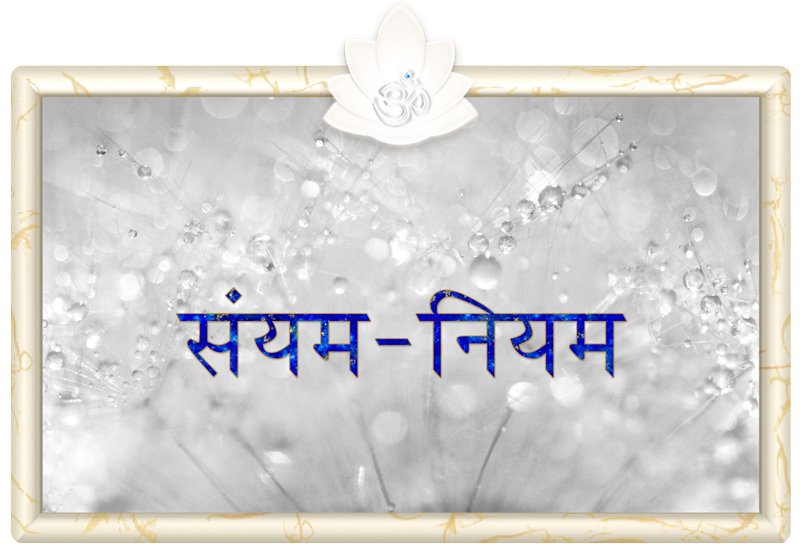संयम-नियम
A Virtue from Gurumayi Chidvilasananda
for June 24, 2020

Commentary by Mark McLaughlin and Ami Bansal
The beautiful virtue that Gurumayi has given to the Siddha Yoga sangham on the occasion of her birthday—June 24, 2020—is संयम-नियम (saṁyama-niyama).
This Sanskrit term holds deep and multilayered meaning which defies direct translation. Yet by investigating the building blocks upon which this term is constructed, we can begin to open up and explore the teachings it contains.
These two words—saṁyama (pronounced “saiyama”) and niyama—are widely used and taught by the sages and saints of India. They both come from the Sanskrit root yam, which means “hold,” “support,” “restrain,” or “rein in.”
The root yam forms the word yama, which literally means “rein” or “bridle,” and signifies self-control and forbearance. Yama is also the name of the lord of dharma, which is the principle that maintains the balance and order of the universe. Everything in nature—the rising and setting of the sun, the cycle of the seasons—performs its duty. It follows its own innate dharma, and in so doing, stays true to its intrinsic nature. This assures there is equilibrium on the planet.
Broadly speaking, saṁyama-niyama is about practicing spiritual discipline; and when you practice this discipline, you are following the path of dharma.
Now let’s look at each of the words—saṁyama and niyama—in more depth. Saṁyama means “self-control.” It refers to reining in the mind and the senses, restraining them, or directing their energies inward so that you remain centered on the inner Self. You do this, for example, by meditating or performing other spiritual practices.
The sage Patanjali says in his revered text, the Yoga Sutra:
तज्जयात् प्रज्ञालोकः
tajjayāt prajñālokaḥ
From the mastery of saṁyama
comes the light of knowledge and insight.1
Regular practice of saṁyama connects you to your own inner knowledge and intuition. You view your life with clearer, sharper perspective. You develop viveka, or discernment, by which you can better make sensible choices from moment to moment—choices that are anchored in and reflect your innate wisdom. As you stay centered within, your inner eye of knowledge guides your thoughts and words, and how you move about and interact with the world.
Gurumayi says:
When [discipline] is present, the mind thinks what it should think, the intellect judges when it should judge, the hands move where they need to move, and the legs go where they need to go. When there is discipline, the energies of the senses function in the way they should. A person in this state experiences great peace.2
It is reassuring to learn that following discipline envelops our life in peace. When the mind and senses are focused and reined in, they become naturally aligned with the Self. Being in the presence of the Self in turn calms the mind and acts as a balm to the agitated and overactive senses.
The second word that makes up this virtue—niyama—is action-oriented. It refers to the specific actions that you take and the spiritual teachings you implement in order to maintain saṁyama. Niyama supports saṁyama in holding the reins of the mind, in bridling the senses, and in bringing about meditative absorption within one’s being.
One key aspect of niyama is that it implies persistence, consistency, and dedication. Thus, the word niyama refers to both the actions you take and the commitment you make to yourself to follow those disciplined actions on a regular basis.
The sage Patanjali lists five essential niyamas in his Yoga Sutra. The first one is śauca, or cleanliness; this is the effort we make to ensure that there is purity and orderliness in our inner and outer lives. The second is santoṣa, or contentment, which in this context refers to our ability to learn and grow in sadhana while remaining calm and happy. Tapas is the third niyama, and it refers to both the spiritual austerities that we undertake in sadhana, and the “heat” or energy that these austerities generate and which further propels our sadhana. The fourth niyama is svādhyāya, or study of the Self through the lens of the Guru’s teachings and the scriptures. Finally, the fifth niyama is īśvara-praṇidhāna: the continuous surrender of our thoughts, words, and actions to God.
So, saṁyama is the inner posture of self-restraint and niyama is what gives form to this self-restraint through the commitments we make and the actions we take. Saṁyama–niyama requires effort—even some hard work—but once we’ve established a rhythm for making that effort, it becomes effortless. The more we anchor ourselves in the virtue of saṁyama-niyama, the more we find ourselves in alignment with the essence of life itself. We acquire a nimbleness that aids us in navigating the fluctuations of the inner and outer worlds with skill, equipoise, and joy. We have the ability to perform actions with wisdom and discernment even in the most tumultuous of times. In fact, we become friends with time, and we are better able to bring our best to each moment—and thereby make that moment an offering to the Lord. We are steady, ready, and proactive when disciplined actions are needed to support our own well-being and the well-being of fellow people, creatures, and the planet.

2Gurumayi Chidvilasananda, Kindle My Heart, 2nd ed. (S. Fallsburg, NY: SYDA Foundation, 1996), p. 70.

